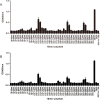Immunisation With Immunodominant Linear B Cell Epitopes Vaccine of Manganese Transport Protein C Confers Protection against Staphylococcus aureus Infection
- PMID: 26895191
- PMCID: PMC4764517
- DOI: 10.1371/journal.pone.0149638
Immunisation With Immunodominant Linear B Cell Epitopes Vaccine of Manganese Transport Protein C Confers Protection against Staphylococcus aureus Infection
Abstract
Vaccination strategies for Staphylococcus aureus, particularly methicillin-resistant S. aureus (MRSA) infections have attracted much research attention. Recent efforts have been made to select manganese transport protein C, or manganese binding surface lipoprotein C (MntC), which is a metal ion associated with pathogen nutrition uptake, as potential candidates for an S. aureus vaccine. Although protective humoral immune responses to MntC are well-characterised, much less is known about detailed MntC-specific B cell epitope mapping and particularly epitope vaccines, which are less-time consuming and more convenient. In this study, we generated a recombinant protein rMntC which induced strong antibody response when used for immunisation with CFA/IFA adjuvant. On the basis of the results, linear B cell epitopes within MntC were finely mapped using a series of overlapping synthetic peptides. Further studies indicate that MntC113-136, MntC209-232, and MntC263-286 might be the original linear B-cell immune dominant epitope of MntC, furthermore, three-dimensional (3-d) crystal structure results indicate that the three immunodominant epitopes were displayed on the surface of the MntC antigen. On the basis of immunodominant MntC113-136, MntC209-232, and MntC263-286 peptides, the epitope vaccine for S. aureus induces a high antibody level which is biased to TH2 and provides effective immune protection and strong opsonophagocytic killing activity in vitro against MRSA infection. In summary, the study provides strong proof of the optimisation of MRSA B cell epitope vaccine designs and their use, which was based on the MntC antigen in the development of an MRSA vaccine.
Conflict of interest statement
Figures






Similar articles
-
Fine-mapping of immunodominant linear B-cell epitopes of the Staphylococcus aureus SEB antigen using short overlapping peptides.PLoS One. 2014 Mar 5;9(3):e90445. doi: 10.1371/journal.pone.0090445. eCollection 2014. PLoS One. 2014. PMID: 24599257 Free PMC article.
-
Multiple B-cell epitope vaccine induces a Staphylococcus enterotoxin B-specific IgG1 protective response against MRSA infection.Sci Rep. 2015 Jul 23;5:12371. doi: 10.1038/srep12371. Sci Rep. 2015. PMID: 26201558 Free PMC article.
-
Improved protective efficacy of a chimeric Staphylococcus aureus vaccine candidate iron-regulated surface determinant B ( N 126- P 361) -target of RNAIII activating protein in mice.Microbiol Immunol. 2013 Dec;57(12):857-64. doi: 10.1111/1348-0421.12106. Microbiol Immunol. 2013. PMID: 24117875
-
Master mechanisms of Staphylococcus aureus: consider its excellent protective mechanisms hindering vaccine development!Microbiol Res. 2018 Jul-Aug;212-213:59-66. doi: 10.1016/j.micres.2018.05.002. Epub 2018 May 4. Microbiol Res. 2018. PMID: 29853168 Review.
-
Towards the immune proteome of Staphylococcus aureus - The anti-S. aureus antibody response.Int J Med Microbiol. 2010 Feb;300(2-3):176-92. doi: 10.1016/j.ijmm.2009.10.002. Epub 2009 Nov 3. Int J Med Microbiol. 2010. PMID: 19889576 Review.
Cited by
-
Characterization and Genomic Analysis of a New Phage Infecting Helicobacter pylori.Int J Mol Sci. 2022 Jul 17;23(14):7885. doi: 10.3390/ijms23147885. Int J Mol Sci. 2022. PMID: 35887231 Free PMC article.
-
Selective substrate uptake: The role of ATP-binding cassette (ABC) importers in pathogenesis.Biochim Biophys Acta Biomembr. 2018 Apr;1860(4):868-877. doi: 10.1016/j.bbamem.2017.08.011. Epub 2017 Aug 25. Biochim Biophys Acta Biomembr. 2018. PMID: 28847505 Free PMC article. Review.
-
EpiMix Based Novel Vaccine Candidate for Shigella: Evidence of Prophylactic Immunity in Balb/c Mice.Int J Pept Res Ther. 2021;27(2):1095-1110. doi: 10.1007/s10989-020-10153-0. Epub 2021 Jan 30. Int J Pept Res Ther. 2021. PMID: 33551691 Free PMC article.
-
Immunogenicity and Protective Capacity of Sugar ABC Transporter Substrate-Binding Protein against Streptococcus suis Serotype 2, 7 and 9 Infection in Mice.Vaccines (Basel). 2024 May 15;12(5):544. doi: 10.3390/vaccines12050544. Vaccines (Basel). 2024. PMID: 38793795 Free PMC article.
-
An Introduction to B-Cell Epitope Mapping and In Silico Epitope Prediction.J Immunol Res. 2016;2016:6760830. doi: 10.1155/2016/6760830. Epub 2016 Dec 29. J Immunol Res. 2016. PMID: 28127568 Free PMC article. Review.
References
-
- Cosseron-Zerbib M, Roque Afonso AM, Naas T, Durand P, Meyer L, Costa Y, et al. A control programme for MRSA (methicillin-resistant Staphylococcus aureus) containment in a paediatric intensive care unit: evaluation and impact on infections caused by other micro-organisms. The Journal of hospital infection. 1998;40(3):225–35. . - PubMed
Publication types
MeSH terms
Substances
LinkOut - more resources
Full Text Sources
Other Literature Sources
Medical

